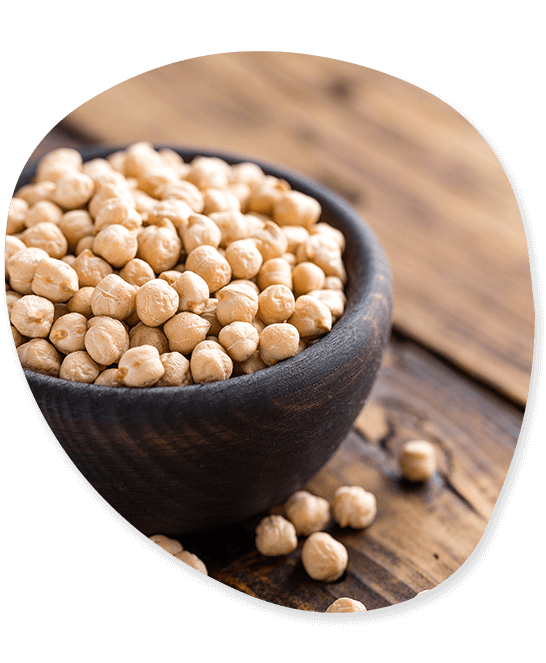Chickpeas
India is one of the countries that produces the most chickpeas in the world, and it exports an increasing amount of chickpeas every year. Generally speaking, there are two types of chickpeas: “Desi” and “Kabuli.” These two kinds of chickpeas are among the numerous that India exports. High-quality chickpeas are exported from India by the chickpea exporter.

Nutrient:
- Calories – 364 calories / 100grams
- Carbohydrates – 61g/100 grams
- Fiber – 17g/100grams
Vitamins:
- Vitamin C
- Vitamin K
- Vitamin B6
Minerals:
- Thiamin
- Riboflavin
- Niacin
- Pantothenic acid
Protein:
- 1.3g
Pre-Shipment Inspection:
- According to the weight and quality requirements specified by the customer.
Standard Packing:
- We provide packaging in terms of 5, 10, 20, 25, 50 and 100kg also, as per the customers’ (country) requirement.
CHICKPEAS VARIETIES WE EXPORT
Numerous types of chickpeas, including L550, JG315, Pusa 391 and other cultivars, are imported from India. The majority of these high-quality types are exported by India’s top chickpea producer. The export of chickpeas from India is rising as a result of the growing popularity of chickpeas around the world.

L 550
In 1978, the L 550 cultivar of chickpeas was introduced. Chickpeas of the L 550 cultivar reach maturity 136–140 days after transplantation. These chickpeas are salmon-colored with noticeable seeds. This kind of chickpeas often yield 17–20 q/ha.

JG 315
In 1984, the JG 315 cultivar of chickpeas was introduced. After transplantation, the JG 315 variety of chickpeas matures in about 125–130 days. These chickpeas feature brown, wrinkled seeds and are wilt-resistant. The average yield of this kind of chickpeas that we export is 19–20 q/ha.

PUSA 391
In 1997, this particular type of chickpeas was introduced. After transplantation, the Pusa 391 variety matures in roughly 110–120 days. These chickpeas are distinguished by their large, light brown seeds. This particular chickpea type has a yield of 17–18 q/ha on average.

BGD 72
The BGD 72 is a different breed of chickpea that India exports, having been introduced in 1999. After transplantation, this variety takes roughly 135 to 140 days to mature. The BGD 72 cultivar is renowned for its robust seeds and resistance to wilt and root rot. This cultivar typically yields 25 to 30 q/ha.

GUJARAT GRAM 1
In 1999, the Gujarat Gram 1 became available. This particular kind of chickpeas matures in about 105-110 days. Generally speaking, these chickpeas are wilt-resistant. This particular chickpea variety has an average yield of 17–22 q/ha.

ICCC 32
Another type of chickpea we export from India is the ICCC 32. These chickpeas, which were introduced in 1985, mature after being transplanted in about 130–150 days. The ICCC 32 seed is a medium size. The typical yield of this cultivar is between 18 and 20 q/ha, and it is typically wilt-resistant.

KAK 2
In the year 2000, the KAK 2 type of chickpeas was introduced. After transplanting, this kind of chickpeas shipped from India takes roughly 125–130 days to maturity. The KAK 2 cultivar often produces strong seeds and yields 17–18 q/ha on average.

UDAY (KPG 59)
Released in the year 1992, Uday or KPG 59 is another variety of chickpeas exported from India. KPG 59 takes around 130-140 days to mature after transplanting. This variety can be characterized by late sowing. The average variety of this variety of chickpeas is 18-20q/ha.

GNG 663 (VARDAN)
In 1995, the GNG 63 was made available. Another name for this variety is Vardan. This particular kind of chickpeas matures in about 150–155 days. This cultivar yields an average of 22–25 q/ha and is tolerant of Ascochyta blight in addition to being resistant to wilt.

KARNA CHANA (CSG 8962)
1997 saw the release of The Karna Chana. This cultivar, also known as CSG 8962, matures after transplantation about 140–147 days. This type is recommended for locations influenced by salt. This particular chickpea variety has an average yield of 22–25 q/ha.
